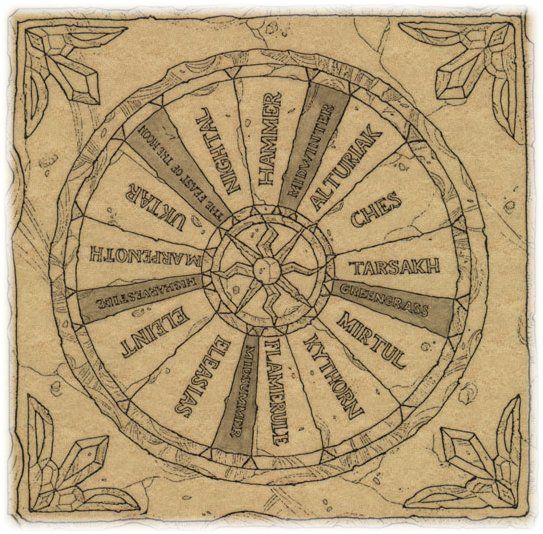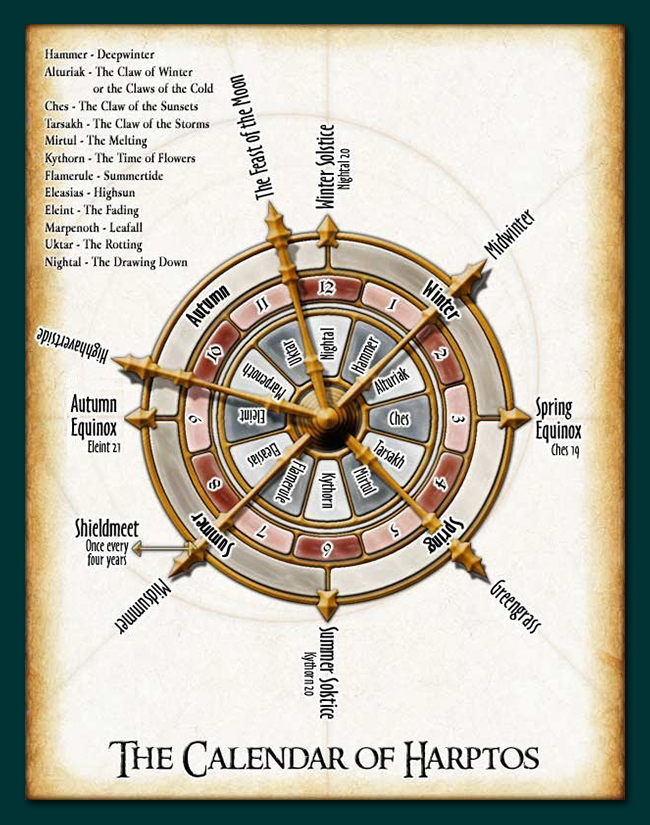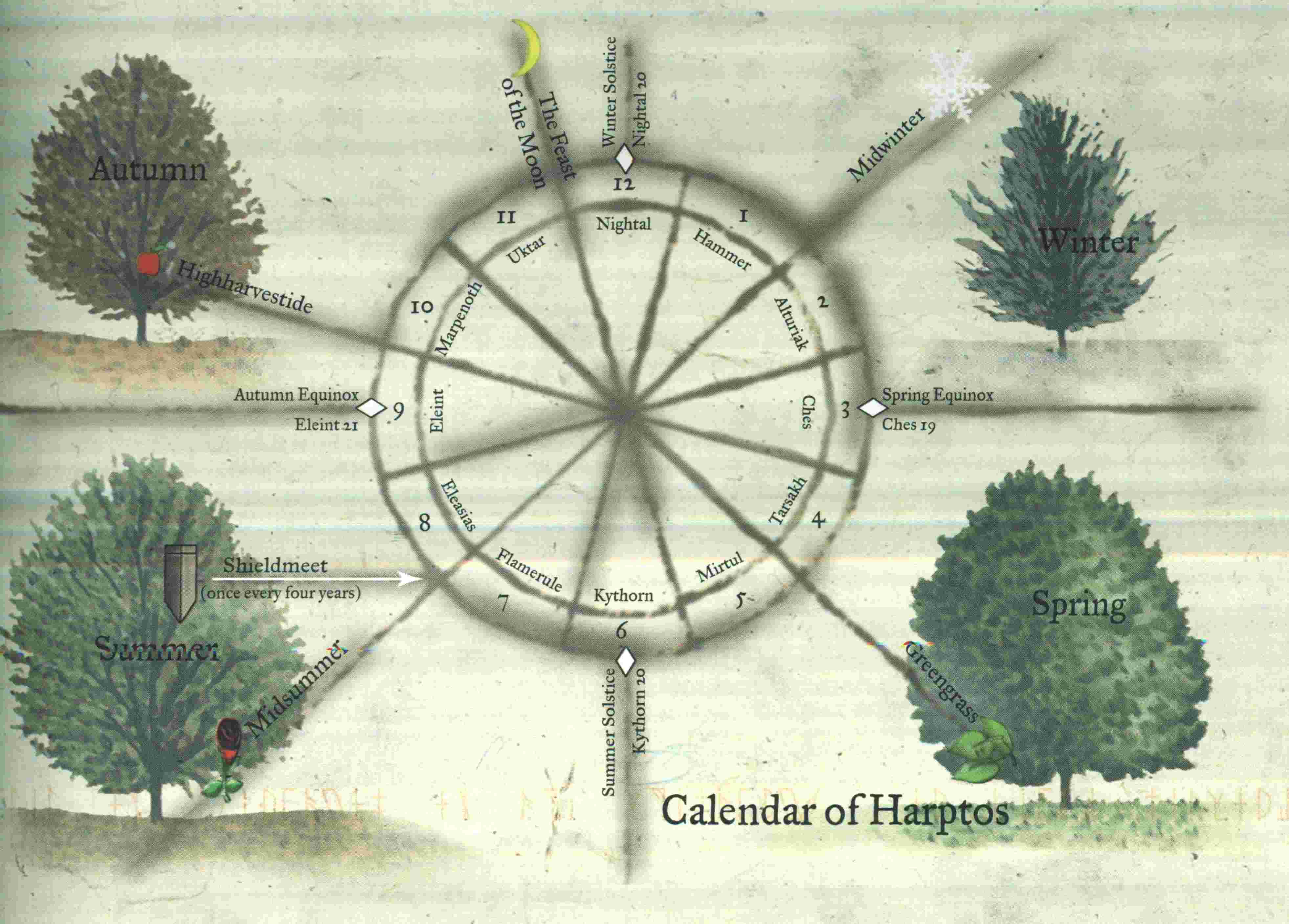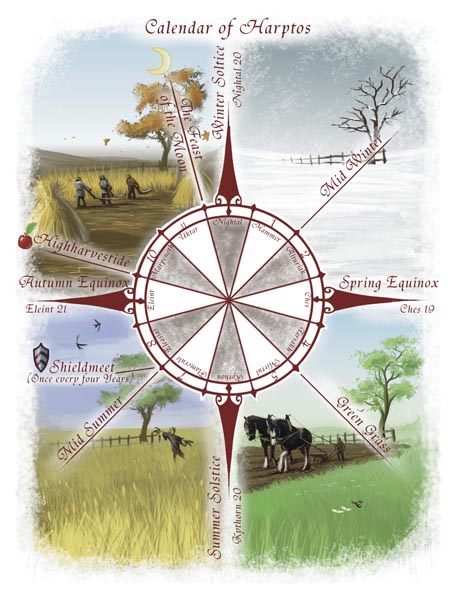The Calendar of Harptos
Almost every person or race of within The Islands and the Old Continent marks the passage of days, seasons, and even years in some fashion. Empires rise, make their marks, and fall in spectacular ways, only to return as ruins later on. The holy days of many gods matter, as do the lineages of kings of the past in the great cities of the Old Continent. All of The Islands and the Free People's settlements of the northern Old Continent use the Calendar of Harptos, named after the long-dead seer who invented it.
Few bother to refer to Harptos by name, however, since the calendar is the only calendar they know. The calendar of years chronicles the complete cycle of days (with important holidays and Shieldmeet “leap days” included), phases of the moon, and even names of all years in their complete and accurate form.
The naming of the years is not random, nor does it necessarily commemorate any great event or occurrence. Many centuries ago, the Lost Sage Augathra the Mad wrote out thousands of years and named them in a great library now forgotten to the folk of The Islands. The “Roll of Years” survived the Great Retreat and it is a rare year that doesn't see some event that seems clearly connected with its name, and most folks view Augathra's names as mysterious portents of the years ahead.
The calendar is split into twelve months, each lasting three tendays (or thirty days). A tenday is also, though less commonly, called a “ride”. There are an additional five days that fall between months, bringing the total number of days in most years to three hundred and sixty five. A Shieldmeet year — a leap year — occurs once every four years, adding an extra day that follows the Midsummer festival.
The days do not have names, but are instead referred to by number: first-day, second-day, and so on. Most people count using their thumbs as first-day; halflings, however, are famous for using their pinkies to count first-day, and thus the phrase “counting like a halfling” has come to mean someone is being different just to be difficult.
A day is twenty four hours long, broken up by the rising and setting sun. Most people break up the day into large slices — dawn, morning, highsun (noon), afternoon, dusk, sunset, evening, midnight, moondark (night's heart), and night's end. In large cities, temple bells toll to mark the hours, and each hour is a “bell” — counting from the hour after midnight or noon and numbering one to twelve. Noon and midnight are both referred to as “twelve bells”.
Seasonal Festivals
Five times a year the annual holidays are observed as festivals and days of rest in almost every civilised land. Each seasonal festival is celebrated differently, according to the traditions of the land and the particular holiday.
Midwinter
Nobles and monarchs greet the halfway point of winter with a feast day they call the High Festival of Winter. Traditionally it's the best day to make or renew alliances. The common folk enjoy the celebration a bit less—among them it's called Deadwinter Day, noted mainly as the halfway point of winter, with hard times still to come.
Greengrass
The official beginning of spring is a day of peace and rejoicing. Even if snow still covers the ground, clerics, nobles, and wealthy folk make a point of bringing out flowers grown in special rooms within temples and castles. They distribute the flowers among the people, who wear them or cast them upon the ground as bright offerings to the deities who summon the summer.
Midsummer
Midsummer night is a time of feasting and music and love. Acquaintances turn into dalliances, courtships turn into betrothals, and the deities themselves take a part by ensuring good weather for feasting and frolicking in the woods. Bad weather on this special night is taken as an omen of extremely ill fortune to come.
Highharvestide
This holiday of feasting to celebrate the autumn harvest also marks a time of journeys. Emissaries, pilgrims, adventurers, and everyone else eager to make speed traditionally leave on their journeys the following day—before the worst of the mud clogs the tracks and the rain freezes into snow.
The Feast of the Moon
The Feast of the Moon celebrates ancestors and the honored dead. Stories of ancestors' exploits mix with the legends of deities until it's hard to tell one from the other.

 BlackengorgeSaga
BlackengorgeSaga


